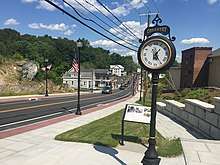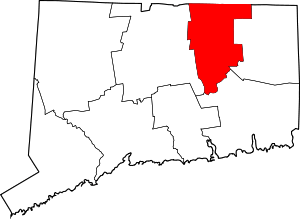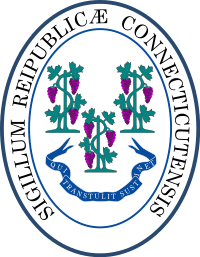Coventry, Connecticut
Coventry (/ˈkɒvəntri/ KOV-ən-tree) is a town in Tolland County, Connecticut, United States. The population was 12,435 at the 2010 census. The birthplace of Captain Nathan Hale, Coventry is home to the Nathan Hale Homestead, which is now a museum open to the public. Coventry was incorporated in May 1712.
Coventry, Connecticut | |
|---|---|
Seal | |
Location in Tolland County, Connecticut | |
| Coordinates: 41°47′04″N 72°20′20″W | |
| Country | |
| U.S. state | |
| County | Tolland |
| Metropolitan area | Hartford |
| Incorporated | 1712 |
| Government | |
| • Type | Council-Manager |
| • Town Manager | John A. Elsesser |
| • Town council | Julie A. Blanchard (R), Council Chair Matthew D. O'Brien Sr (R), Vice-Chair Richard L. Williams Jr (R), Secretary Matthew D. O'Brien Jr (R) Jonathan B. Hand (D) Lisa K. Conant (D) Lisa D. Thomas (D) |
| Area | |
| • Total | 38.4 sq mi (99.5 km2) |
| • Land | 37.7 sq mi (97.7 km2) |
| • Water | 0.6 sq mi (1.7 km2) |
| Elevation | 656 ft (200 m) |
| Population (2010) | |
| • Total | 12,445 |
| • Density | 330.0/sq mi (127.3/km2) |
| Time zone | UTC-5 (EST) |
| • Summer (DST) | UTC-4 (EDT) |
| ZIP code | 06238 |
| Area code(s) | 860 |
| FIPS code | 09-17800 |
| GNIS feature ID | 0213413 |
| Major highways | |
| Website | www |

Geography
According to the United States Census Bureau, the town has a total area of 38.4 square miles (99 km2) of which 37.7 square miles (98 km2) is land and 0.6 square miles (1.6 km2) (1.67%) is water.
Principal communities
- North Coventry
- South Coventry
- Coventry Lake
History
Coventry was named in October 1711, the first town in the colonies to be named "Coventry" for Coventry in the West Midlands, United Kingdom.[1]
Settlement and founding
The first house in Coventry was said to have been built near the shore of Lake Wangumbaug by Nathaniel Rust, a Hartford, Connecticut, man, originally from Northampton, Massachusetts. The entire Rust family is said to have made their final move to Coventry from Massachusetts in a group of a dozen families in 1709. Along with Nathaniel Rust, the names of some of the earliest settlers were David Lee, Thomas Root, Samuel Gurley, Ebenezer Searl, Joseph Petty, Benjamin James and Benjamin Carpenter. Four other settlers were also from Northampton and two from Reading.[2]
The land was said to have originally been given to men from Hartford by Joshua, Indian sachem. The Connecticut General Assembly, held in Hartford in 1706, appointed William Pitkin, Joseph Tallcot, William Whiting and Richard Lord, as a committee with full power to lay out the bounds of the town and divisions of the land, to admit inhabitants. A 1711 revision added Nathaniel Rust to the committee and the task of procuring a minister of the gospel.[3] The first church was established in October 1714.
St. Mary's Church is a Roman Catholic church in Coventry. The church is part of the Diocese of Norwich, located at 1600 Main Street in town.
The Middle Post Road, one of the three Boston Post Roads declared in 1671 with the creation of the Colonial post, ran through Coventry. The Post Roads were meant to connect the colony of New York, formerly New Amsterdam, with the Massachusetts Bay Colony. Middle Post Road connected Hartford and Boston, MA via Coventry and Pomfret, CT, and Mendon and Roxbury, MA.
To the present
The old center of the town is in South Coventry, near the intersection of Main Street (Route 31) and Stonehouse Road (Route 275). In the 19th century, there was a small industrial center including mills powered by the water from Coventry Lake Brook as it flowed towards the Willimantic River. South Coventry Village, listed on the National Register of Historic Places, also includes several Victorian houses, a museum, the main branch of the public library and the Bidwell Tavern, a bar/restaurant established in 1822. The Bidwell used to keep Coventry's town records in the "vault" area behind the bar, as well as hosting town meetings.[4] A few doors away is the W.L Wellwood General Store, which under new ownership has been renamed "Coventry Country Store". The general store was originally built in 1787 making it one of, if not the oldest General Store in America (a past owner claimed to have not found an older store). In all, the area has over 100 historical buildings on the national register.
North Coventry's settlement is less dense, and its housing and businesses are of more recent construction. In the 18th century, this section of the town was largely used for dairy and vegetable farming. As the United States expanded westward, many farming families left the rocky fields of Connecticut for the more fertile land of the Ohio River valley. Most of the farms in North Coventry were abandoned, and the land reclaimed by second-growth forest. In the 1960s and 1970s, tract housing developments were built on some of this land, mainly raised ranch or split-level houses on one acre (4,000 m²) lots. Development slowed from the mid-1970s through the 1990s, but several new developments were constructed in North Coventry after 1990. These tend to feature larger houses on two acre (8,000 m²) lots.
Places of interest
- Wangumbaug Lake, also known as Coventry Lake, covers 373 acres (1.51 km2). The lake is fed by springs, and has one natural outlet, known as Coventry Lake Brook. The brook flows towards South Coventry center and ultimately into the Willimantic River. Patriots Park, located on Wangumbaug Lake, contains a guarded beach, playground, picnic area, lodge facilities, Community Center, and band shell for summer concerts. It is also home of the Coventry Lake Water Ski Team and UConn Men and Women’s Crew Teams. The boat launch is run by the State of Connecticut. Occasionally, during the winter months, the lake will freeze over and residents have the opportunity to skate or fish on the ice. A lake island, Underwood Island, is located 100 yards from the coast of the lake.
- Nathan Hale Homestead, first established around 1740 by Deacon Richard Hale (1717–1802), the present structure has been standing since 1776 and was built to house the combined family of Deacon Hale and his second wife Abigail (Cobb) Adams. The original house, birthplace of Nathan Hale in 1755, is said to have been on the property, just southeast of the 1776 house. The original 450 acres (1.8 km2) of the Hale farm now make up a large portion of the Nathan Hale State Forest. Today the Hale family home, located on South Street, is a museum open seasonally for tours and education programs.
- The Strong-Porter House Museum, circa 1730, is listed on the National Register of Historic Places and serves as the Coventry Historical Society's museum. Five rooms of the house, as well as several outbuildings, including a carpenter shop, carriage sheds, and barn are open to the public.
- The Brick School House, second construction completed in 1825 after original burned, it is one of the four remaining district schoolhouses in Coventry and was used through 1953.
- Caprilands Herb Farm, c.1740 colonial farmstead, home for over 65 years to the late famed herbalist and author, Adelma Grenier Simmons, an herbal mecca open to the public. Visitors can enjoy one of many themed herbal and floral gardens, including the Cook's Garden, Saint's Garden, Shakespeare Garden, Medieval Garden and Bride's Garden.
- Hytone Farm, owned and operated by the Peracchio family since the early 1940s and a fully operational dairy farm since 1960, they raise all their own Holstein cows, currently have 165 young stock and use over 350 acres (1.4 km2) of corn and grass for silage. Hytone Farm has received many Distinguished Farming awards through their years.
- Museum of Connecticut Glass is a new museum focusing on glassmaking in the state.[5]
On the National Register of Historic Places
- Brigham's Tavern — 12 Boston Tpke. (added April 25, 1982)
- Capron-Phillips House — 1129 Main St. (added May 27, 1982)
- Captain Nathan Hale Monument — 120 Lake St. (added February 28, 2002)
- Coventry Glass Factory Historic District — US 44 and N. River Rd. (added September 27, 1987)
- Elias Sprague House — 2187 South St. (added December 2, 1987)
- Loomis-Pomeroy House — 1747 Boston Tpk. (added May 26, 1994)
- Nathan Hale Homestead — 229 South St. (added November 22, 1970)
- Parker-Hutchinson Farm — Parker Bridge Rd. (added May 29, 1982)
- South Coventry Historic District — Roughly, Main St. and adjacent streets from Armstrong Rd. to Lake St. and Lake from High St. to Main (added June 6, 1991)
- Strong-Porter House — 2382 South St. (added February 15, 1988)
Annual events
Memorial Day-Memorial Day Parade—Capt. Nathan Hale is recognized along with members of the Armed Forces
- CoventryFest -- with fireworks, food and live music. Held in early July at Patriot's Park on the lake.
- June 6 -- Captain Hale's Birthday Party -- held at the Hale Homestead
- July -- Colonial Encampment and Muster -- July—held by the Nathan Hale Ancient Fife & Drums at the Hale Homestead.
- December--"Old-Fashioned Christmas in Coventry". Main Street first Saturday in December.
Demographics
| Historical population | |||
|---|---|---|---|
| Census | Pop. | %± | |
| 1790 | 2,130 | — | |
| 1800 | 2,021 | −5.1% | |
| 1810 | 1,938 | −4.1% | |
| 1820 | 2,058 | 6.2% | |
| 1850 | 1,984 | — | |
| 1860 | 2,085 | 5.1% | |
| 1870 | 2,657 | 27.4% | |
| 1880 | 2,043 | −23.1% | |
| 1890 | 1,875 | −8.2% | |
| 1900 | 1,632 | −13.0% | |
| 1910 | 1,606 | −1.6% | |
| 1920 | 1,582 | −1.5% | |
| 1930 | 1,554 | −1.8% | |
| 1940 | 2,102 | 35.3% | |
| 1950 | 4,043 | 92.3% | |
| 1960 | 6,356 | 57.2% | |
| 1970 | 8,140 | 28.1% | |
| 1980 | 8,895 | 9.3% | |
| 1990 | 10,063 | 13.1% | |
| 2000 | 11,504 | 14.3% | |
| 2010 | 12,435 | 8.1% | |
| Est. 2014 | 12,419 | [6] | −0.1% |
| U.S. Decennial Census[7] | |||
At the 2010 census,[8] there were 12,435 people, 4,783 households and 3,426 families residing in the town. The population density was 330.0 per square mile (127.3/km2). There were 4,783 occupied housing units. 316 vacant housing units. The racial makeup of the town was 94.00% White, 0.90% African American, 0.20% Native American, 0.80% Asian, 0.00% Pacific Islander, 0.20% from other races, and 1.40% from two or more races. Hispanic or Latino of any race were 2.60% of the population.
There were 4,783 households which 31.1% had children under the age of 18 living with them, 59.5% were married couples living together, 7.7% had a female householder with no husband present, and 28.4% were non-families. 20.9% of all households were made up of individuals and 6.6% had someone living alone who was 65 years of age or older. The average household size was 2.59 and the average family size was 3.01.
23.3% of the population were under the age of 18, 12.1% from 15 to 24, 25.0% from 25 to 44, 33.2% from 45 to 64, and 10.6% who were 65 years of age or older. The median age was 41.5 years. 50.6% of the population were male and 49.4% were female. 38.4% of the males were over the age of 18. 38.2% of the females were over the age of 18. For every 100 females, there were 102.2 males. For every 100 females age 18 and over, there were 100.8 males.
The median household income was $86,244, and the median family income was $91,931. Males had a median income of $65,572 versus $53,690 for females. The per capita income for the town was $34,524 About 2.4% of families and 3.1% of the population were below the poverty line, including 2.9% of those under age 18 and 1.1% of those age 65 or over.
| Voter Registration and Party Enrollment as of October 29, 2019[9] | |||||
|---|---|---|---|---|---|
| Party | Active voters | Inactive voters | Total voters | Percentage | |
| Democratic | 2,520 | 79 | 2,599 | 28.57% | |
| Republican | 2,084 | 63 | 2,137 | 23.49% | |
| Unaffiliated | 4,050 | 158 | 4,208 | 46.26% | |
| Minor Parties | 138 | 4 | 142 | 1.56% | |
| Total | 8,792 | 304 | 9,096 | 100% | |
Education
- Coventry Grammar School, K - Grade 2
- G. H. Robertson Intermediate School, Grade 3 - Grade 5
- Capt. Nathan Hale Middle School, Grade 6 - Grade 8
- Coventry High School, Grade 9 - Grade 12
Notable people
- Jesse Root (1736–1822) was a Coventry resident who served in the Continental Congress representing Connecticut from 1778 until 1782 and sat as chief justice of the Connecticut Supreme Court from 1796 to 1807. Buried in Nathan Hale Cemetery.
- Nathan Hale (1755–1776), captain in the Continental Army during the American Revolutionary War and official State Hero of Connecticut, was born in town. Empty grave in Nathan Hale Cemetery.
- Lorenzo Dow (1777–1834), an important figure in the Second Great Awakening, an eccentric, itinerant minister, was born in town.
- George N. Barnard (1819–1902), photographer who joined Mathew Brady in recording the American Civil War, worked briefly with photographic pioneer George Eastman, and the Eastman Kodak Company, was born in town.
- Benoni Irwin (1840–1896), American portrait painter and summer resident, drowned in Coventry Lake. Buried in Nathan Hale Cemetery.
- Adelma Grenier Simmons (1903–1997), author and one of the leading herbal figures in America in the 20th century, owned and operated Caprilands Herb Farm for over 65 years, lived in town.
- David Hayes (1931-2013), artist, American Modern Master of painted steel sculptures, lived in town.
- Allan Sherman (1924-1973), hunter, fisherman, antique home renovator, author of outdoor novellas "Walk Like A Squirrel" and "Wrestling The New England Wild Turkey".
Sister cities
Notes
- Cole, J. R., History of Tolland County, Connecticut W.W. Preston and Co., 1888
- Philips, David E., Legendary Connecticut / ISBN 1-880684-05-5 /
Climate
This climatic region is typified by large seasonal temperature differences, with warm to hot (and often humid) summers and cold (sometimes severely cold) winters. According to the Köppen Climate Classification system, Coventry has a humid continental climate, abbreviated "Dfb" on climate maps.[12]
External links
| Wikimedia Commons has media related to Coventry, Connecticut. |
References
- The Connecticut Magazine: An Illustrated Monthly. Connecticut Magazine Company. 1903. p. 331.
- "Archived copy". Archived from the original on 2006-08-13. Retrieved 2006-09-14.CS1 maint: archived copy as title (link)
- "Archived copy". Archived from the original on 2006-07-12. Retrieved 2006-09-14.CS1 maint: archived copy as title (link)
- http://articles.courant.com/1994-10-21/news/9410210701_1_town-hall-office-building-life-size-statue
- Connecticut Glass Museum website
- "Annual Estimates of the Resident Population for Incorporated Places: April 1, 2010 to July 1, 2014". Archived from the original on May 23, 2015. Retrieved June 4, 2015.
- "Census of Population and Housing". Census.gov. Retrieved June 4, 2015.
- "U.S. Census website". United States Census Bureau. Retrieved 2015-01-03.
- "Registration and Party Enrollment Statistics as of October 29, 2019" (PDF). Connecticut Secretary of State. Retrieved 2020-01-04.
- Griffin, Mary (2011-08-02). "Coventry's twin towns". Coventry Telegraph. Archived from the original on 2013-08-06. Retrieved 2013-08-06.
- "Coventry - Twin towns and cities". Coventry City Council. Archived from the original on 2013-04-12. Retrieved 2013-08-06.
- Climate Summary for Coventry, Connecticut

